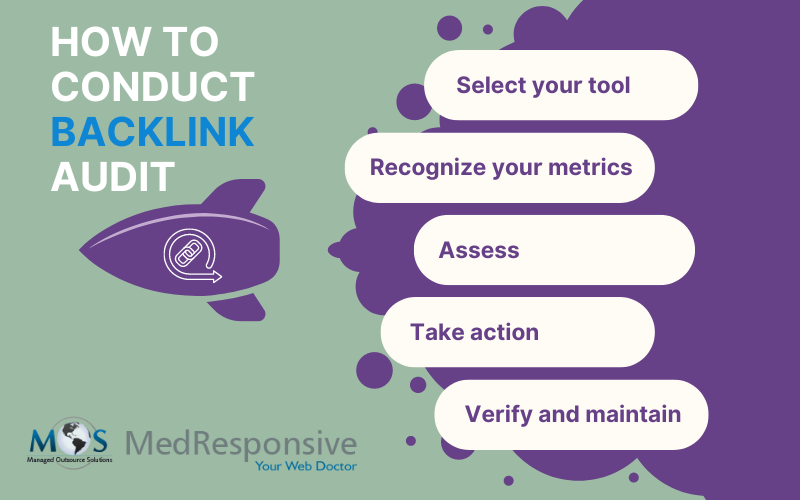When it comes to SEO, nothing quite compares to high-quality backlinks — the links coming to your website from other websites. Backlinks play a crucial role in SEO as they are seen as votes of confidence and authority from other websites. Google gives backlinks high priority in its ranking system. But obtaining high-quality backlinks is a challenging task. Backlinks originating from low-quality, spammy, or unrelated websites can potentially have a negative impact on your website’s search engine ranking. Reliable organic SEO services will conduct a backlink audit, help you get rid of harmful links, and help in effective link building to improve your website’s ranking.
What is a Backlink Audit?
A backlink audit provides you with a comprehensive report and analysis of these links. This includes information about which domains and pages are linking to your website, which particular pages are receiving the links, and information about the IP addresses, categories, anchor text, types of links (follow vs. no follow), and authority ratings of those referring links that can be used to evaluate the quality of those connections. Backlink audit tools are designed to identify and highlight these observations, providing valuable insights and recommendations. These tools can suggest actions such as whitelisting high-quality backlinks or disavowing low-quality or harmful backlinks in order to optimize your website’s backlink profile.
Benefits of Backlink Audits
Backlink audit or analysis involves examining the backlinks pointing to a website from external sources. It provides valuable insights into a website’s link profile, helps identify areas for improvement, and guides the development of effective link building strategies. Let’s dive into the benefits of backlink analysis for SEO.
- Identifies linking opportunities: Acquiring high-quality links is just as crucial as removing bad ones. You can find websites that might be worth contacting for a more deliberate initiative by conducting a backlink audit. In order to identify broken or poisonous connections, you can also analyze the backlink profile of another website and propose your link as a substitute.
- Investigate traffic anomalies: Backlinks can be a contributing factor to fluctuations in traffic performance. It is surprising to see how a relatively small group of backlinks, whether from a specific website or a particular geographic area, can generate a substantial amount of traffic to your website. However, it is important to note that these backlink sources are vulnerable to algorithmic changes, policy updates, and privacy modifications. Such alterations can lead to significant variations in the traffic directed to your website.
- Prevent lost traffic opportunities: A backlink audit can help identify broken backlinks that are pointing to your website, revealing potential missed opportunities for traffic.
- Prevent Google penalties: Google utilizes various methods to identify unnatural backlinks acquired through black hat SEO techniques in line with its Expertise, Authoritativeness, Trustworthiness (E-A-T) guidelines. Even if you are not intentionally involved in such practices, instances of website and comment spam can occur. Conducting a backlink audit can help prevent your website from being penalized by Google and ensure compliance with their guidelines.
- Remove any negative links: When a website connects to your, Google associates you with that website. A backlink audit will detect your toxic backlinks that come from spammy, dubious, or low-credibility websites, which you should remove or disavow.
Five Steps to Conduct Backlink Audit
- Recognize your metrics: Even the most basic of audit reports can be confusing if you don’t know backlink jargon. Here’s some important information to check for in a backlink audit:
- Number of backlinks: Though the number of backlinks is less significant than quality, it’s still useful to compare your position to that of your rivals.
- Number of referring domains: Since a single domain might connect to your website more than once, this statistic will always be lower than the number of backlinks.
- Authority score: Also referred to as Domain Authority, this score evaluates a website’s trustworthiness using a variety of EEAT variables, including backlinks. You have access to both your own Authority Score and the Authority Scores of the websites that link to yours.
- Top linked pages: Identify the pages that have the highest number of backlinks on your website.
- Top linking domains: The websites that connect to you the most are known as top linking domains.
- Link velocity is the number of fresh backlinks you receive every week.
- Link toxicity is a measurement of the quantity of bad links, or links from spammy, low-authority, or hazardous websites, that point to your website.
- Assess: A diverse range of anchor text types – such as keyword and non-keyword, branded and non-branded – as well as an assortment of Authority Scores from referring domains characterize a sound backlink profile. This suggests that you have gradually and morally gained these connections. Check the quality of your links to make sure they accurately represent your work and reliability.
- Take action: Your backlink assessment may yield several action items. Here what you should pay attention to:
- High-quality backlinks should be marked as safe, reliable, or sites to contact for additional chances. This is known as a whitelist.
- Eliminate unwanted backlinks: Contact the websites in question and request removal of any detrimental backlinks.
- Disavow toxic backlinks: You can create a Google Search Console disavow list if you have a lot of toxic backlinks or if you can’t convince the website to take down the link. Asking Google to reject certain links and detach them from your website is known as “disavowing.” For additional information on disavowing links, visit Google’s help page.
- Fix broken links: To fix broken backlinks link or create redirects, contact the referring domain.
- Verify and maintain: Run your audit tool one more time after completing your action items to check whether your scores have changed. Additionally, plan frequent backlink scans and configure alerts for recently added, broken, or vanished backlinks.
Top Tools for Backlink Audits
Google Search Console: You can get direct backlink data from Google through the Google Search Console. It offers a wealth of insightful information, such as:
- The number of backlinks that point to your website
- Anchor text that other websites use to connect to your page
- The websites you link to the most
- The websites referring to your content
- Penalties for manually linking (if any)
Setting up Google Analytics is also a smart move, as this service offers valuable metrics for your website. Though it is free, in comparison to other options, this tool doesn’t offer as much link context. Due to this issue utilizing Search Console alone to evaluate link quality and identify issues or opportunities is challenging.
Ahrefs: Ahrefs is a widely used backlink audit tool. It offers comprehensive details about your backlink profile, including:
- The quantity of domains that link to your website, or referring domains.
- The rating of your domain (DR). This number assigns a score to your backlink profile relative to other websites, ranging from 100 to 1.
- Which of your pages are getting the most backlinks
- Anchor text data: Details about other websites that link to yours using your anchor text.
- The country of the referring domains.
Ahrefs has much more context-rich links than Search Console, which is its main advantage. And using domain rating is a simple approach to evaluate the link profile of other websites as well as your own. However, this instrument is a little pricey, particularly for beginners.
Moz: Moz offers a ton of crucial backlink information. With Moz, you’ll get access to your:
- The total number of domains linking to you
- Domain authority – a search engine ranking score that predicts how likely a website is to rank in search engine result pages (SERPs)
Spam Score is MOZ’s ranking factor. When your website get links from a spammy websites, your spam score will increase.
Do you want to know the best SEO tactics to link building,
Read our blog post,
Essential Tools for In-Depth Backlinks Analysis in SEO.
Performing an assessment of backlinks is a crucial aspect of SEO. It assists in locating problematic links that could lower the authority and reputation of your website. Make sure to focus on obtaining high-quality backlinks from reliable and pertinent websites. Collaborating with a reliable provider of organic SEO services can ensure knowledge, experience, and comprehensive backlink audits to maintain your online reputation and search engine ranking.
Don’t let harmful links affect your website’s authority.
Partner with us for a professional backlink audit.





